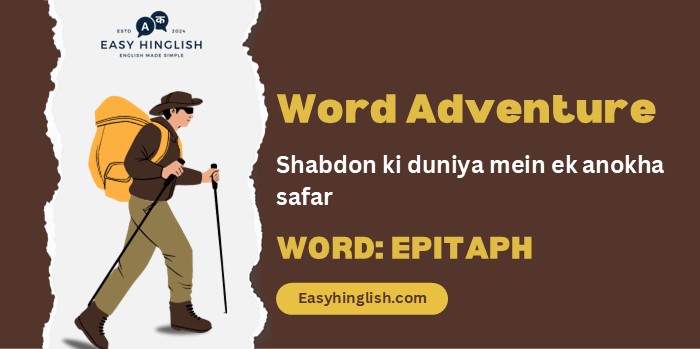Word Adventure: Epitaph
The Headline
“Final Words: Kaise Epitaphs Capture Karte Hain Life’s Essence in Stone Aur Memory”
The Scoop
Humari legacy preserve karne ke many ways mein se, few are as poignant as epitaph – woh carefully chosen words jo mark karte hain hamari final resting places. More than simple identifiers, epitaphs represent karte hain hamari last communication with world, distilling entire lives into brief phrases jo meant hain echo through time. Chaliye explore karte hain is word ko jo bridge karta hai realm of living aur remembered, aur discover karte hain ki kyon yeh concise memorial inscriptions continue move karte hain humein centuries after they’re carved.
Let’s Break It Down
The Plot Thickens
Epitaphs ki history stretch back karti hai ancient civilizations tak, jahan woh serve karte the not only to mark graves but preserve essence of deceased for posterity. Ancient Romans aur Greeks apni epitaphs quite seriously lete the, using them to celebrate accomplishments, lineage, aur character. Yeh merely markers nahi the – woh portals of memory the, keeping the dead present in minds of living.
Medieval times tak, epitaphs evolve ho gaye the to include religious elements, prayers for soul common features ban gaye the. Renaissance brought revival of classical forms, Latin epitaphs experiencing renewed popularity among educated elite. Throughout these eras, epitaphs serve karte the as important historical documents, capturing not just individual lives but reflecting larger cultural values aur beliefs about death aur remembrance.
Literary epitaph – separate from actual tombstone inscriptions – become ho gaya art form in its own right. Poets like Ben Jonson, John Donne, aur later, Thomas Gray, ne elevate kiya epitaph ko high art tak, creating memorable verses jo contemplated mortality with elegance aur insight. Kuch of these literary epitaphs eventually find kar gaye apna way onto actual tombs, blurring line between literature aur memorial.
Perhaps most fascinating yeh hai ki kaise epitaphs evolve hue formulaic statements se highly personalized expressions tak. Terse “Here lies” inscriptions se elaborate verses aur even humorous remarks tak, epitaphs reveal karte hain changing attitudes toward death aur self-representation across centuries aur cultures.
Word in the Wild
The Twist
Yahan kuch thought-provoking hai: hamari digital age mein, kya hum create kar rahe hain new forms of epitaphs without realizing it? Consider kijiye ki kaise social media profiles become karte hain digital memorials after someone passes away, preserved exactly jaise unhone leave kiye the. Ya kaise last tweet ya Instagram post jo koi make karta hai unwittingly becomes unka final public statement. Kuch services ab offer karte hain “digital tombstones” – QR codes on physical gravestones jo link karte hain multimedia memorials online. Yeh evolving forms suggest karte hain ki while medium changes, hamari fundamental desire to be remembered – to leave our mark with final words – remains utna hi strong jitna jab first epitaphs carve kiye gaye the stone mein thousands of years ago.
Make It Stick
Epitaph: Life ka final punctuation – jahan period become ho jaata hai exclamation point in stone!
Your Turn
Kya aapko kabhi koi memorable epitaph mila hai jo moved, amused, ya inspired kiya ho aapko? Ya aapne kabhi consider kiya hai ki aap kya want karte hain as your own epitaph someday? Share kijiye apne thoughts comments mein below. After all, contemplating ki hum kaise remembered ja sakte hain can be powerful way to reflect on ki hum kaise living kar rahe hain today!
Down the Rabbit Hole
- Famous epitaphs ke baare mein curious hain? Research kijiye Oscar Wilde, Dorothy Parker, ya Benjamin Franklin ke for some witty aur profound examples.
- Tombstones par symbolism mein interested hain? Explore kijiye ki kaise imagery like weeping willows, broken columns, ya clasped hands complement karte the epitaphs to tell fuller stories.
- Epitaphs mein regional aur cultural variations discover karna chahte hain? Dekho traditions from New Orleans ke elaborate tombs se New England slate markers ki stark beauty tak.
The Last Word
Jaise hum ‘epitaph’ ki exploration conclude karte hain, main hope karta hoon ki aapne appreciation gain ki hai in concise but profound markers of lives lived ke liye. Ek aisi duniya mein jo endless words aur constant communication se bhari hai, kuch powerfully humbling hai epitaph ke baare mein – woh final distillation of who we were aur what we meant to others. Perhaps epitaph ka greatest gift yeh hai ki yeh remind karta hai humein to live lives worthy of remembrance, not merely in grand achievements but in kindness, love, aur authenticity. Until our next word adventure, yeh hoon main Prashant from Wordpandit, aap sabko encourage karta hoon ki write kijiye apni life story well before anyone attempts its summary in stone!








